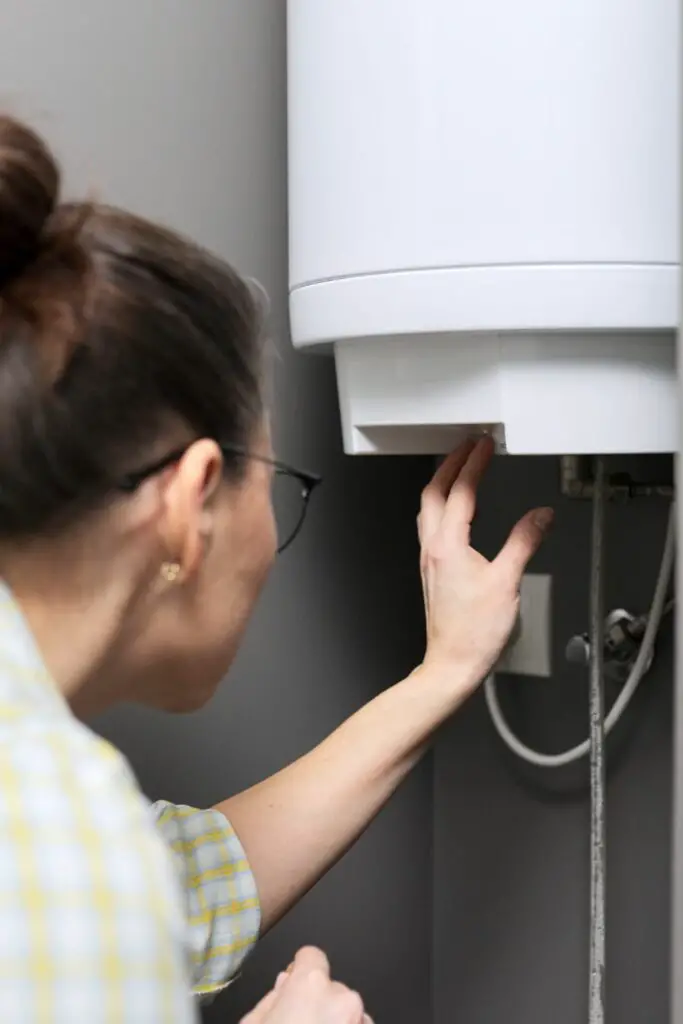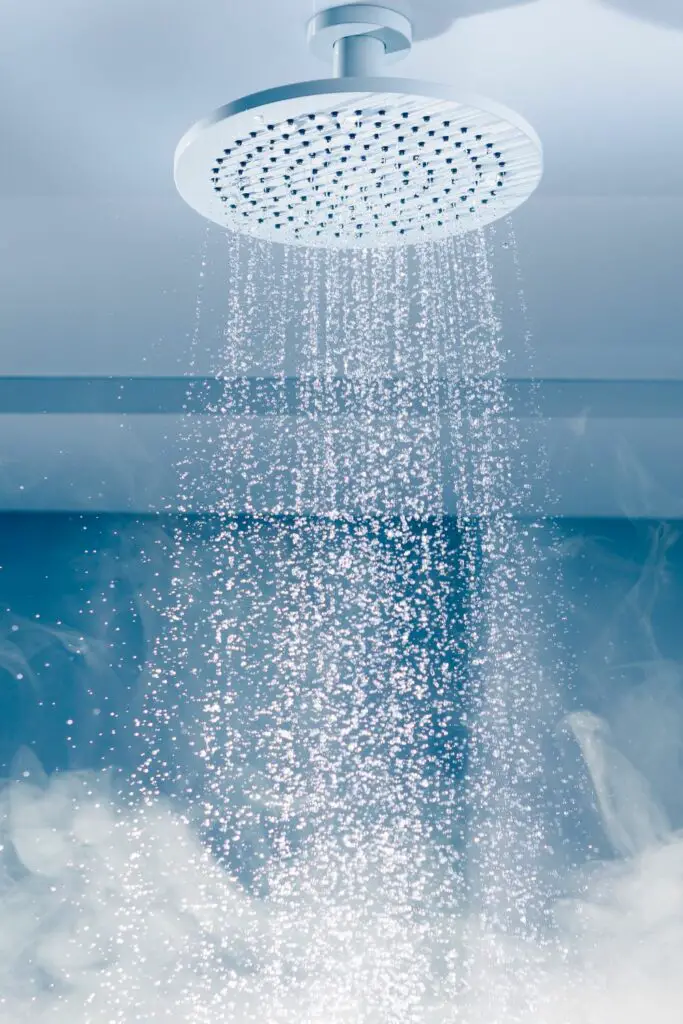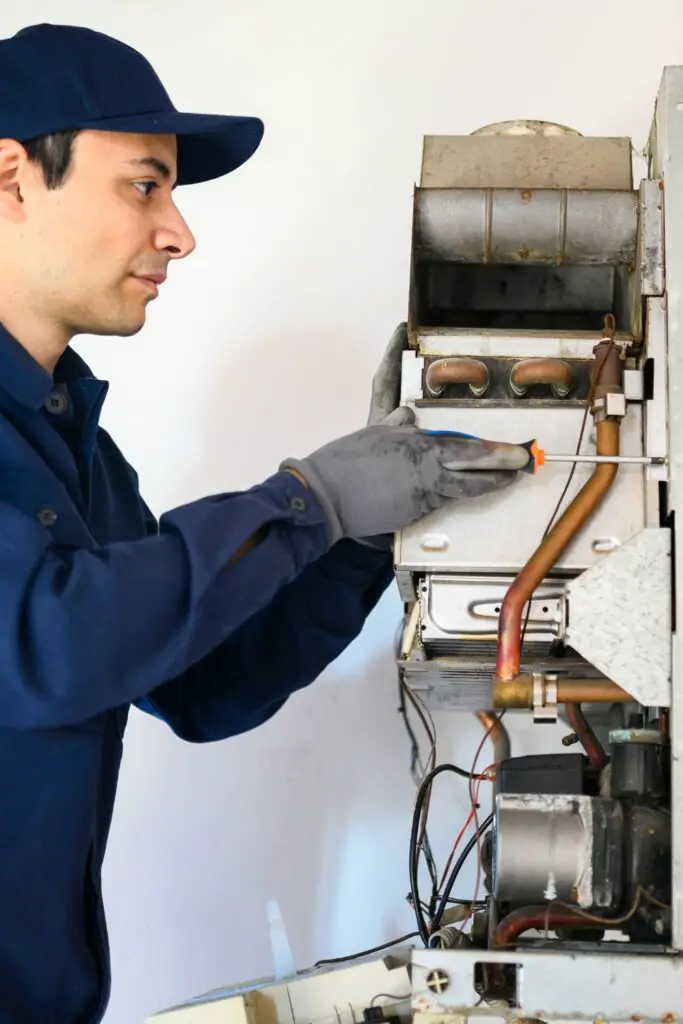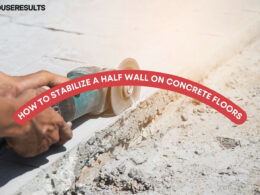Table of Contents Show
Have you ever stepped into a shower upstairs, expecting a soothing cascade of hot water, only to be greeted by an unwelcome blast of cold? It’s a common frustration in two-story homes where the warmth flows freely in the kitchen tap downstairs but is a no-show in the upstairs bathroom.
As a seasoned homeowner and a contractor with a track record of happy clients, I’ve seen this issue more times than I can count. And yes, it can be fixed.
You might wonder why the hot water that’s so abundant on the first floor seems to play hide and seek when you head upstairs. It’s not just an inconvenience; it can signal that something’s amiss with your home’s hot water system. But don’t worry; you’re not alone in this, and more importantly, there are solutions at hand.
In this post, we’ll explore the common causes behind this temperature tangle and walk through practical fixes that can restore the balance, ensuring that hot water is readily available at every tap in your home, upstairs, and downstairs. Stick with me, and let’s get that hot water flowing right up to where you need it.
Understanding Your Home’s Hot Water System

To tackle the hot water mystery, it’s essential to start with the basics of how hot water systems function. At its heart, a typical system has a straightforward job: heat water and deliver it to your taps and appliances.
This process begins in your water heater, where cold water is warmed up by electric elements or a gas burner, and then sent through your pipes to reach every hot water outlet in the house.
1. Explanation of How Typical Hot Water Systems Work
In its simplest form, hot water flows from your heater through a network of pipes. When you turn on a tap, pressure sends the water into your faucet. This pressure is generated by the water pump, which is essential in moving water through the system, or by gravity, which naturally pulls the water down from an elevated tank.
2. Differences Between Single-Story and Multi-Story Plumbing
Single-story homes typically have shorter, more direct plumbing routes, making it easier for hot water to reach its destination quickly. On the other hand, multi-story homes have to contend with gravity and additional piping that can create more complex pathways for the hot water to travel, potentially leading to the issues at hand.
3. Importance of Water Pressure and Its Role in Hot Water Delivery
According to ‘This Old House,’ a well-known authority on home improvement, maintaining the right water pressure is crucial for an effective hot water system. Too low, and your water trickles out, struggling to reach far-off faucets, especially those upstairs.
Too high, and you risk damage to your pipes and appliances, not to mention the possibility of leaks. For most homes, an ideal pressure is between 40 to 60 pounds per square inch (psi).
Understanding these fundamentals provides a foundation to uncover why hot water is plentiful downstairs but becomes a rare commodity upstairs. With this knowledge, we’re now equipped to identify and fix the problem, ensuring a steady and comfortable hot water supply in every corner of your home.
Common Causes of Hot Water Discrepancies Between Floors
When you’re faced with the conundrum of having hot water downstairs but not upstairs, there are several culprits to consider. Let’s get into what might be putting a damper on your hot showers upstairs, even when the lower levels of your home are enjoying all the heat they need.
1. Gravity and Water Pressure Issues in Multi-level Homes
In multi-level homes, gravity and water pressure need to work together harmoniously. If the pressure isn’t strong enough to overcome gravity, hot water will struggle to ascend to your higher floors. This imbalance often results in hot water comfortably reaching the ground floor but failing to make the climb upstairs.
2. Malfunctioning Anti-Scald Devices or Pressure-Balancing Valves
These safety devices are designed to protect you from sudden temperature changes. However, if they’re not working correctly, they can restrict the flow of hot water. An anti-scald device that’s stuck or a pressure-balancing valve that’s malfunctioning can reduce the hot water reaching your upstairs fixtures.
3. Sediment Buildup in Water Heaters Affecting Water Flow
Over time, sediment can accumulate at the bottom of your water heater, especially in areas with hard water. This buildup can insulate the water from the heater’s elements or burner, reducing efficiency and clogging the system, making it harder for hot water to reach the upper floors.
4. Blockages or Airlocks in the Plumbing System
Blockages from debris or air trapped in the pipes (airlocks) can prevent water from flowing smoothly through your home’s plumbing. These issues can be more pronounced in the vertical pipes leading to the second floor.
5. Faulty Plumbing Design or Installation
Sometimes the root cause comes down to the initial design or installation of your plumbing system. If the layout doesn’t adequately account for the additional demands of upper floors, you might experience insufficient hot water supply where you need it most.
6. Thermostat Issues on Dual-Element Water Heaters
For water heaters with two elements, if the upper thermostat or element goes bad, you’ll likely have a decent supply of hot water on the first floor for a short period, but the recovery time will be longer, affecting the supply upstairs.
7. Check Valves and Their Influence on Hot Water Distribution
Check valves, which prevent backflow and maintain directional water flow, can also play a part. If a check valve is improperly installed or failing, it can disrupt the balance of hot water distribution between floors.
Pinpointing the exact cause of your hot water woes can be tricky, but understanding these common issues is the first step toward a solution. Each of these scenarios provides a potential explanation for why your upstairs taps are giving you the cold shoulder, and recognizing them is critical for applying the right fix.
Diagnostic Tips for Identifying the Problem
Before you can fix the problem, you need to pinpoint what’s causing the disparity in hot water distribution between your downstairs and upstairs. Here are some diagnostic strategies that can lead you to the heart of the issue:
1. How to Check for Pressure Imbalances
Checking for pressure imbalances should be one of your first steps. You can do this with a simple water pressure gauge that attaches to a spigot. Ideal home water pressure should be between 40 to 60 psi. If you notice a significant difference in pressure readings between your downstairs and upstairs faucets, you’ve likely found a clue to your hot water mystery.
2. Inspecting Your Water Heater Settings and Parts
Take a look at your water heater. First, check if the temperature settings are consistent with your needs. It should be set between 120°F and 140°F for most households. Then, inspect the parts. If you have a dual-element heater, verify that both elements are functioning correctly. Any signs of corrosion or damage could point to the source of the problem.
3. Testing for Blockages or Airlocks
Blockages and airlocks in your pipes can be identified by turning on all hot water taps in the house. If water sputters or comes out inconsistently, you might have air trapped in the pipes.
Alternatively, a complete lack of water suggests a blockage. Isolating sections of your plumbing and using a drain cleaner or a plunger can sometimes resolve these issues.
4. Assessing the Plumbing Design
Sometimes, the issue may be more complex, rooted in the plumbing design itself. Check the diameter of your pipes; smaller pipes can reduce flow and pressure. Also, look for any unnecessary bends or long horizontal runs that could hinder water flow to the upper floors.
If you’re not comfortable evaluating your plumbing layout, this might be a step where consulting a professional is wise.
Remember, diagnosing plumbing issues can be as much about observation as it is about action. Keep an eye out for any discrepancies in water flow or pressure as you conduct these checks, and make notes of what you find. These observations will be crucial when it comes time to apply fixes or to explain the situation to a professional if needed.

Preventive Measures to Avoid Future Hot Water Issues
A stitch in time saves nine, and this is particularly true when it comes to maintaining your hot water system. By taking proactive steps, you can prevent the hassle of inconsistent hot water in your home. Here are some tips to help you keep the hot water flowing smoothly to every faucet.
Regular Maintenance Tips for Your Hot Water System
- Annual Flushing: Perform an annual flush of your water heater to remove sediment that can hinder its efficiency and affect water flow.
- Check Pressure Relief Valve: Regularly check the pressure relief valve on your water heater to ensure it’s operating correctly, which will also keep pressure in the system at appropriate levels.
- Monitor Water Pressure: Keep an eye on your home’s water pressure. If it consistently reads too high or too low, installing a pressure regulator can help.
- Insulate Pipes: Consider insulating your hot water pipes. This can reduce heat loss as water travels to your upstairs taps, especially during colder months.
- Temperature Settings: Periodically verify that your water heater’s temperature setting is at the optimal range, usually around 120°F to 140°F, to balance efficiency and comfort.
The Importance of Professional Inspections
While DIY checks are valuable, there’s no substitute for a professional inspection. Having a licensed plumber inspect your system every few years can catch issues that may not be visible to the untrained eye, such as corroded pipes or a failing heating element.
Professional inspections can extend the life of your hot water system and ensure it runs efficiently.
Upgrades and Improvements for Older Systems
For older systems, considering upgrades and improvements can be a worthwhile investment.
- Tankless Water Heaters: These provide hot water on demand and eliminate the losses associated with traditional tank systems.
- Recirculation Systems: A hot water recirculation system can provide instant hot water to upstairs bathrooms, reducing the wait and waste of cold water.
- New Fixtures: Installing newer fixtures with better flow rates can also enhance your system’s performance and ensure a steady stream of hot water.
- Energy-Efficient Models: If your heater is nearing the end of its lifespan, replacing it with a more energy-efficient model can provide more consistent heat and reduce utility bills.
Preventive maintenance, along with timely upgrades, not only safeguards against future hot water problems but also enhances your home’s value and comfort. By following these measures, you can enjoy the peace of mind that comes with a reliable hot water supply in every corner of your home.
Step-by-step Fixes for Restoring Upstairs Hot Water
When you’re faced with the challenge of hot water being available downstairs but not upstairs, there are several steps you can take to troubleshoot and potentially resolve the issue. Here’s a systematic approach:
1. Adjusting Your Water Heater Settings
- Check Temperature Dial: Ensure that your water heater’s temperature setting is not set too low, which could affect the hot water supply, especially for fixtures that are farthest from the heater.
- Balance the Load: If you have a dual-element water heater, make sure both elements are working properly. An upper element malfunction could lead to insufficient hot water for upstairs use.
2. Flushing Out Sediment from the Water Heater
- Turn Off the Heater: For safety, turn off the power or gas to the unit before proceeding.
- Connect a Hose: Attach a garden hose to the drain valve located at the bottom of the heater and lead it to an appropriate drain.
- Drain and Flush: Open the drain valve and let the tank empty. Then, turn on the cold water supply to flush out any remaining sediment. Be careful as the water will be hot.
3. Replacing or Repairing Malfunctioning Valves
- Identify Faulty Valves: Pressure-balancing valves or anti-scald devices in your showers could be malfunctioning, affecting hot water flow.
- Access and Inspect: Remove the handle and trim from the shower valve to inspect and access the cartridge or valve.
- Replace if Necessary: If a valve is found to be defective, replace it with a new one that matches your system’s specifications.
4. Addressing Check Valve Adjustments or Replacements
- Locate Check Valves: Check valves may be installed on your hot water lines to prevent backflow.
- Adjust or Replace: If a check valve is stuck, it may need adjustment or replacement. Ensure that valves are installed in the correct orientation to allow proper flow.
5. Dealing with Airlocks in Your Hot Water Lines
- Identify Airlocks: Turn on the hot water tap farthest from the heater. If water sputters or fails to flow, this could indicate an airlock.
- Clear the Airlock: You can attempt to clear it by attaching a hose between the hot and cold water taps and opening both for a short period to allow pressure to push the air out.
6. Professional Solutions for Systemic Plumbing Issues
- Complex Issues: If the above steps don’t resolve the issue, you may have a more systemic problem such as a blockage, improperly sized pipes, or an inadequately sized water heater.
- Consult a Professional: In such cases, it’s best to consult with a professional plumber who can diagnose and fix issues like poor plumbing design or the need for additional equipment.
Following these steps may restore the flow of hot water to your upstairs taps. However, if you find yourself uncertain at any stage or if the problem persists, it’s prudent to consult a professional to ensure your home’s plumbing integrity is maintained.
When to Call a Professional Plumber

Tackling hot water issues can sometimes be a DIY project, but there are instances where the best course of action is to call in a professional. Knowing when to pick up the phone can save you time, money, and a whole lot of cold showers.
Situations That Require Expert Attention
Certain situations are clear indicators that it’s time to call a plumber. These include:
- When you’ve exhausted all the basic troubleshooting steps without success.
- If there’s evidence of water leakage or water damage.
- When you encounter complex problems with your water heater, like a failing heating element or a broken dip tube.
- If you suspect that your plumbing system’s design is the cause.
- Any time you feel out of your depth, especially when dealing with gas or electric components.
How to Find a Reliable Plumbing Service
Choosing a reliable plumber is essential for quality and long-lasting repairs.
- Seek Recommendations: Start by asking friends, family, or neighbors for their go-to plumbing service.
- Check Reviews and Ratings: Online platforms can provide reviews and ratings from previous customers.
- Verify Credentials: Ensure that any plumber you consider is licensed and insured, which protects you and your property during repairs.
- Experience with Similar Issues: Look for plumbers who have experience dealing with hot water issues in homes similar to yours.
The Benefits of Having a Go-To Professional for Plumbing Issues
Establishing a relationship with a professional plumber comes with several benefits:
- Preventive Advice: Plumbers can offer personalized advice on preventing future issues based on their understanding of your home’s plumbing system.
- Quick Response: A familiar plumber might be more willing to provide quick service, especially in emergencies.
- Trust and Safety: Knowing that your plumber is reliable and consistently performs high-quality work brings peace of mind.
- Efficient Upgrades: A plumber who knows your system can make informed recommendations on upgrades, saving you money in the long run.
In conclusion, while it’s great to handle minor fixes on your own, recognizing when a problem is beyond your expertise will save you time and protect your home from further damage. A professional plumber is a valuable resource for ensuring your hot water system runs efficiently and effectively.













